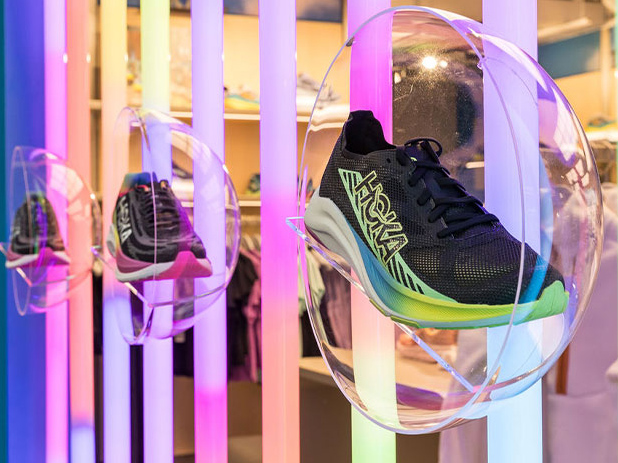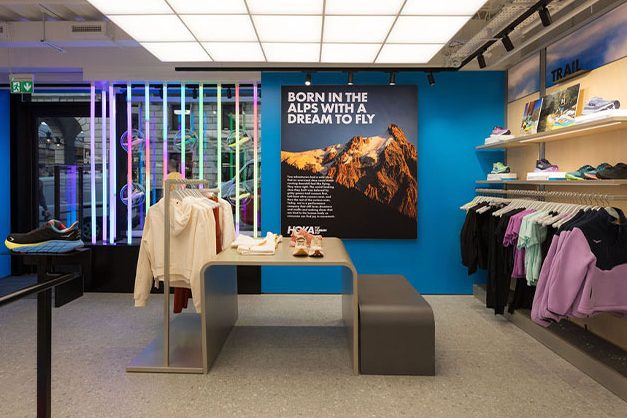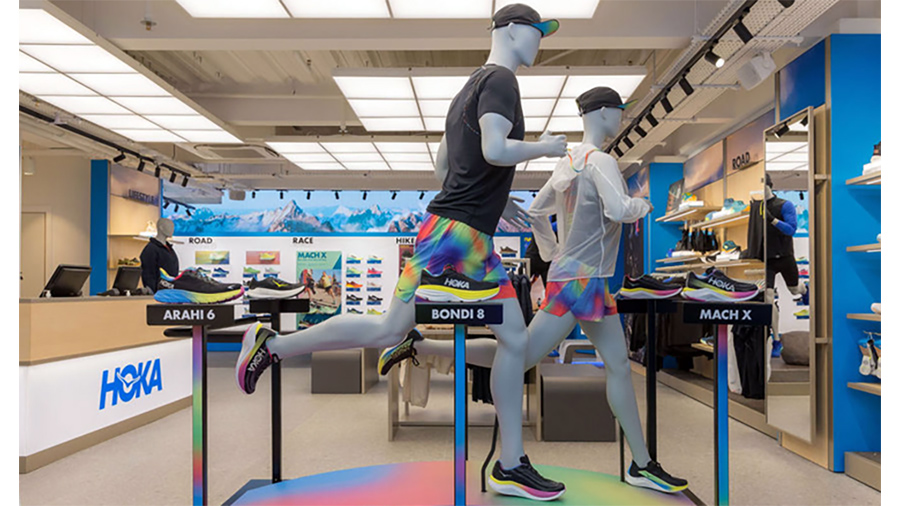Deckers Brands hiked its annual guidance as results for its fiscal second quarter ended September 30 were boosted by a robust recovery at Ugg. However, Hoka’s momentum showed no signs of slowing down with company management telling analysts the brand has become the leading footwear seller in the U.S. run specialty channel.
“Market share gains continue to be the primary avenue of wholesale growth for Hoka, which is now the top-selling brand in U.S. run specialty stores in the aggregate, according to third-party market sources,” said Dave Powers, president and CEO, Deckers Brands, on a call with analysts. “Hoka has also quickly become the top-running brand with key strategic partners in applicable doors.”
Powers added, “Our teams are extremely proud of the Hoka brand’s top market share achievement, which further validates the brand’s performance-rooted credibility.”
Deckers’ Q2 Sales Climb 25 Percent
Companywide sales in the second quarter ended September 30 increased 24.7 percent to $1.09 billion, topping analysts’ consensus target of $960.6 million. On a constant-currency basis, sales increased 24.2 percent for the period.
Among its two largest brands, Ugg sales jumped 28.1 percent to $610.5 million while Hoka sales climbed 27.3 percent to $424.0 million. Hoka’s sales came in line with expectations while Ugg’s exceeded internal plans with the benefit of improved inventory availability and a moved-up fall marketing campaign.
Among its smaller brands, Teva’s sales slumped 28.4 percent to $21.5 million, Sanuk’s fell 28.5 percent to $5.4 million, and sales of other brands, primarily composed of Koolaburra, increased 7.2 percent to $30.6 million.
Direct-to-Consumer Leads Channel Gains In Q2
By channel, direct-to-consumer (DTC) saw the largest growth, as expected, as part of its Marketplace Management strategy. DTC sales in the quarter jumped 38.8 percent to $331.7 million with comparable sales ahead 36.8 percent. Hoka’s DTC sales expanded 46 percent in the quarter while Ugg’s DTC business climbed 38 percent as both brands experienced a greater than 30 percent global increase in consumer acquisition.
Wholesale sales grew 19.4 percent to $760.2 million, led by a 25 percent increase at Ugg. Powers said wholesale gains for both Hoka and Ugg benefited from some accelerated fall seasonal shipments. He said, “As we continue to focus on our strategic Marketplace Management, we are pleased to have captured this strong momentum of demand early in the year, particularly with these products capturing high levels of full-price selling across all channels”
Earnings Tops Estimates By $2.42
Earnings rose 75.9 percent to $178.5 million, or $6.82 a share, well above analysts’ consensus estimate of $4.40 a share.
Gross margin climbed 520 basis points to 53.4 percent of sales, benefitting from lower ocean freight rates, favorable Ugg product mix partially driven by earlier fall demand, favorable Ugg full-price mix, favorable channel mix with DTC continuing to grow faster than wholesale, and a slight benefit from foreign currency exchange rates.
SG&A expenses were up 22 percent year over year but down 80 basis points as a percent of sales to 32.8 percent.
Hoka Delivers 27 Percent Growth In Six Months
Powers said Hoka’s revenues in the fiscal six-month year-to-date period ended September 30 (YTD) jumped 27 percent, supported by “high full-price sale through at our existing points of wholesale distribution” but led by 54 percent DTC growth. DTC represented 38 percent of Hoka’s revenue in the fiscal first half, up from 31 percent in the prior-year comparable period.
Powers said the overall gains were led by global increases in brand awareness. Deckers’ proprietary brand tracker study shows consumer acquisition is up 47 percent versus last year while consumer retention is ahead 52 percent. Hoka experienced significant growth in awareness across all major markets, with the U.S. growing to approximately 30 percent, and international regions, on average, rising to mid-teens.
 In the EMEA, DTC sales jumped 75 percent year-over-year with consumer acquisition nearly doubling.
In the EMEA, DTC sales jumped 75 percent year-over-year with consumer acquisition nearly doubling.
Powers said, “Although DTC remains a relatively small percentage of its total revenue, we see this expansion as a positive indicator that Hoka is increasingly resonating with the European consumer. As we have demonstrated in the U.S., thoughtfully building brand awareness through marketing activations and strategic marketplace presence served as a catalyst to DTC acceleration as the brand begins to take hold with the local consumer.”
Hoka recently opened its first European flagship store in Covent Garden, in London.
In the U.S., Hoka “continues to deliver exceptional growth,” said Powers. DTC revenue advanced nearly 50 percent versus last year for the first half, with strong growth among 18 to 34-year-old retained consumers, which increased by 70 percent.
 “We believe some of this demand was fueled by Hoka having increased resonance in the back-to-school timeframe with college-age students,” said Powers. “Brand loyalty among this group is especially exciting given the increased potential lifetime value of repeat purchases.”
“We believe some of this demand was fueled by Hoka having increased resonance in the back-to-school timeframe with college-age students,” said Powers. “Brand loyalty among this group is especially exciting given the increased potential lifetime value of repeat purchases.”
The awareness among younger consumers was attributed to Hoka’s “Fly Human Fly” campaign which highlighted the brand’s sponsored events and ambassadors. A major recent sponsorship is the UTMB, or Ultra-Trail Mont-Blanc World Series Finals, held in Chamonix, France. Powers said, “At the UTMB World Series Finals, the Hoka team set up a base camp that offered consumers the opportunity to engage with the brand in a unique way through athlete meet-and-greets, 24-hour product testing, and shoe personalization. We received overwhelmingly positive feedback on the experience, and are already looking forward to leveraging these learnings at future events.”
From a product standpoint, Hoka’s growth was driven across a variety of categories and styles. These include the launch of Clifton lifestyle versions with suede uppers; stability staples like the Arahi and Gaviota franchises; Challenger and Anacapa in the trail and hike category; Rocket X Refresh and the all-new Mach X in speed shoes; and Solimar and Transport among new lifestyle styles. Powers said, “We remain encouraged by the breadth of category adoption across the innovative Hoka product assortment which continues to evolve and attract new consumers to the brand.”
In the Q&A session, Powers indicated he’s not concerned about competitors in the running space increasingly targeting the maximalist cushioning trend.
Powers said, “We’ll address how the oversized trends are evolving for us. And we’re taking that very seriously. We don’t want to lose that dominant position in the category that we created. There is a lot of activity, obviously, from competitive brands going in that direction, some good, some bad. But the bottom line is we’re not as differentiated as we were three or four years ago with that type of profile. But our technology, our focus on materials and geometry, product testing, new use of plates, different foams, different compounds, et cetera, continue to be at the forefront of everything we do. But we are addressing the fact people may want a little bit of low profile, they want different uses for their product. We think there’s a tremendous opportunity in trail and hike, we’re going to go heavy after that. We have a dominant position in that already.”
Power said Hoka’s focus for the rest of the year will remain on finetuning segmentation to ensure wholesale accounts are “best positioned to serve their respective consumers” while the brand emphasizes DTC “as the pinnacle destination” to experience the full range of Hoka’s offering, including apparel.
Powers said, “For the balance of the year, the Hoka team remains focused on executing its Marketplace Management strategy which includes a focus on building global brand awareness and heat to increase demand which is helping to drive high full-price sell-through at DTC and across wholesale, allowing the brand to deliver healthy growth with best-in-class margins and inventory turns. Complemented by several new innovative product launches coming up in our fourth quarter, we expect Hoka to continue delivering strong results for the remainder of this fiscal year and well beyond.”
Ugg Sales Benefit From Earlier Fall Campaign
Ugg sales growth of 28.1 percent in the quarter accelerated from a gain of 6.0 percent in its June quarter and marked a rebound from an overall decline of 2.7 percent in its fiscal year ended March 31.
Ugg’s better-than-expected performance in the quarter benefited in part from more consistent transit times and improved supply chain logistics that led to more wholesale shipments landing in the second quarter versus being captured in the first quarter due to the pandemic-related logistic challenges in recent years.
The arrival the Ugg’s Fall marketing campaign, Feel Like Ugg, in July as opposed to the typical September timeframe, drove brand heat, including earlier seasonal purchases. Finally, Ugg saw an increased level of demand for the brand during the back-to-school period, leading some wholesalers to request shipments on an accelerated timeframe relative to their original plan.
Powers said Ugg’s global sales in the first half increased 18 percent, crediting the growth to the brand’s disciplined Marketplace Management strategy, leading to product scarcity on key styles exiting last Fall, as well as the intentional pull forward of the brand’s fall marketing campaign relative to past years. He said, “We currently have the most cohesive globally aligned product, marketing, and consumer targeting strategy I’ve ever seen for Ugg.”
He added, “The allocation and segmentation of core and popular new styles continue to serve the brand well helping drive high levels of full-price sell-through.”
Powers noted that last year, Ugg did not fully capture demand on several key styles, leading to the brand to move up its fall campaign to July. The shift drove a “groundswell of influencer public service announcements” extolling the brand and led to year-over-year search interest increasing 46 percent on Google Trend during the back-to-school season.
A video collaboration with rapper Cardi B in the latter part of September around the new Classic Dipper style drove nearly 20 million views to further drive momentum. Powers said, “Brand heat, created by the Ugg team, directly translated to incredible first-half results, particularly from the global DTC business and international regions, which both experienced a revenue increase of above 25 percent versus last year.”
Among styles, the Tasman franchise, including the Taz platform, as well as the Classic Mini and Ultra Mini franchises have been the focal products of Ugg’s search interest and revenue growth in the first half, as expected. Also seeing strong early demand among fall offerings is the Classic Dipper; the Weather Hybrid collection, including updated, weather-enforced versions of the Tasman and Neumel; and the Lowmel, a sneaker hybrid take on the original Neumel.
“Considering the demand we’ve seen thus far, we are already in chase mode for a select group of popular items and colors, for which we are expediting production to ensure greater DTC inventory through the season,” said Powers of Ugg. “The Ugg brand’s first-half growth sets us up well, especially when factoring in the signals of a weakening global economy and lower consumer confidence. Given this dynamic, we are glad to have captured some demand earlier to help reduce the pressure of competing with more promotional brands during this upcoming holiday season, as we see to continue selling premium Ugg products at full price.”
Sanuk To Be Divested
Deckers also indicated that Sanuk, the surf-inspired brand acquired in 2021, would be divested.
Powers said on the call, “At Deckers, we’re focused on the most effective allocation of our resources that are in alignment with long-term objectives. Consumers have long valued Sanuk for its fun, innovative, and comfort-first products. Over the coming months, we will work to find the right owner to support the brand’s next chapter while we continue to execute our growth priorities.”
In the Q&A session, Powers elaborated on the decision: “I’m really proud of how the teams have managed this brand over the last few years from a Marketplace Management standpoint, and the product right now is very, very strong. But what we’ve realized is that the journey to scale that brand so that it’s meaningful in our portfolio is just too long. There are other things that we think we can invest in, and we think that this is a brand that the consumers love, it deserves a good home, and somebody who can is a priority for them versus a fourth or fifth brand in our portfolio. So, it’s a tough decision emotionally and financially, but I think it’s the best thing for the company and the brand to do this.”
Outlook
Looking ahead, sales for the fiscal year ended March 31, 2024, are expected to reach $4.03 billion, representing a year-over-year gain of 11 percent. Previous guidance called for sales of approximately $3.98 billion.
- Ugg is now expected to see mid-single-digit sales growth, up from prior expectations of low single digits.
- Hoka sales are still expected to increase above 20 percent for the fiscal year, with third-quarter percentage growth anticipated to be slower due to this year’s timing of product launches being weighted towards the Deckers’ fiscal fourth quarter.
- Expectations for Teva have been reduced due to the softening macro backdrop.
Gross margin is now expected to be in the range of 52.5 percent to 53 percent of sales, up from prior guidance of 52 percent. The change reflects the strength of Ugg full-price selling in the fiscal second quarter as the brand was able to capture DTC demand early.
SG&A as a percent of sales is now expected to be in the range of 34 percent to 34.5 percent compared with previous guidance of 34 percent due to continued investments in growth.
The operating margin is now expected to be approximately 18.5 percent of sales, up from 18 percent previously, due to the higher margin expectation.
EPS is now projected in the range of $22.90 to $23.25 per share, up 19.1 percent at the midpoint compared to $19.37 in fiscal 2023. Previous guidance called for EPS between $21.75 to $22.25.
Photos courtesy Hoka
















